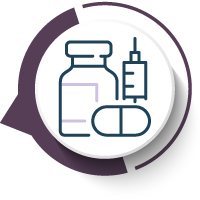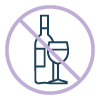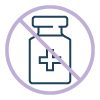Learning Objectives
By the end of this topic, the student should be able to:
- Describe the importance of providing education to opioid users.
- Describe what opioids are and how they work to relive pain.
- Explain why opioids are prescribed.
- Describe the side effects of opioid use.
- Describe additional risks associated with opioid use.
- Educate on how to safely use opioids.
- Describe how and when it is appropriate to wean off opioids.
- Discuss the importance of cooperating with the prescriber.
- Describe types of community harm reduction resources.
Key Concepts
- Health and social service professionals play an important role in educating persons and their significant others about safe opioid medication use.
- Opioids are powerful pain relievers that work by blocking pain signals within the nervous system.
- Opioids are prescribed to reduce acute and chronic pain and improve function.
- Short-term side effects of opioid use include constipation, nausea or vomiting, drowsiness, dizziness, dry skin, and itching. Chronic opioid use can lead to breathing problems during sleep, hormonal effects, depression and anxiety, hyperalgesia, and dry mouth causing tooth decay.
- Additional risks associated with opioid use can include opioid use disorder (OUD), tolerance, dependence, and overdose.
- To ensure safe use of opioids, the treatment plan should be followed very carefully.
- It may be time to consider weaning off opioids when the long-term risks outweigh the benefits or the client has minimal or no pain. A slow taper in addition to the use of non-prescription pain relievers and non-pharmacological methods can assist in the process.
- It is important to be familiar with community-specific harm reduction resources, including where to obtain needles and naloxone kits, and whether additional harm reduction resources such as supervised consumption or overdose prevention sites exist in the community.
Providing Education About Opioids
Health and social service professionals, such as dentists, physicians, pharmacists, nurses, and social workers, play a key role in providing client education.

Lucky7trader/iStock
- By providing relevant and reliable information about opioids and ensuring the individual has an adequate understanding, health and social service professionals can help to prevent adverse drug events.
- Information should be provided to caregivers, family, and friends of the person using opioids as they can all play an important role in the safe use of opioid medications. Interprofessional collaboration and documentation should be used when providing education to minimize duplication of information and improve quality of care.
What Are Opioids and How Do They Work?

Opioids are a group of medications that are very good at relieving pain.
- They are more powerful than non-prescription medications such as Tylenol (acetaminophen) or Advil (ibuprofen).
- Pain relief is increased when opioids are combined with non-pharmacological methods of pain relief. Examples include:
- exercise,
- heat and cold therapy,
- physiotherapy, and
- counselling.
Opioids work by blocking pain signals within the nervous system. Opioids can also help to reduce the stress and anxiety caused by pain.
Opioids are commonly known as “narcotics” or “opiates.” See the table below for some other common names.
- There are several kinds of opioids that come in various dosage forms.
- Opioids can be short-acting (IR/SA) or long-acting (ER/LA).
| Generic name | Trade name | Street names |
|---|---|---|
| buprenorphine | BuTrans | bupe, bute |
| buprenorphine-naloxone | Suboxone | subby, bupe, sobos |
| codeine | Tylenol 2, 3, 4 (codeine + acetaminophen) | cody, captain cody, T1, T2, T3, T4 |
| fentanyl | Abstral, Duragesic, Onsolis | patch, sticky, sticker, nerps, beans |
| hydrocodone | Tussionex, Vicoprofen | hydro, vike |
| hydromorphone | Dilaudid | juice, dillies, dust |
| meperidine | Demerol | demmies |
| methadone | Methadose, Metadol | meth, drink, done |
| morphine | Dorloral, Statex, M.O.S | M, morph, red rockets |
| oxycodone | OxyNEO, Percocet, Oxycocet, Percodan | oxy, hillbilly heroin, percs |
| pentazocine | Talwin | Ts |
| tapentadol | Nucynta | unknown |
| tramadol | Ultram, Tramacet, Tridural, Durela | chill pills, ultra |
Canadian Centre on Substance Use and Addiction. (2017). Canadian drug summary: Prescription opioids.
Take a moment to watch the following National Geographic video, explaining what happens in the brain when opioids are used.
Why Are Opioids Prescribed?
Generally, opioids are prescribed after all other options are exhausted.
Opioids may be prescribed to:
- treat pain associated with cancer or other chronic conditions, or
- for short-term relief of severe pain, such as following a serious injury or surgery.
NOTE: Not everyone experiencing these types of pain requires treatment with an opioid medication.
Opioids can help to improve a person’s ability to engage in activities that they were previously able to do before the pain.
Risks Associated With Opioid Use
There are significant risks to be aware of when using opioids. Be aware of the following side effects assicoated with opioid use:
Short-term side effects
- nausea
- constipation
- drowsiness
- dizziness
- dry skin or itching
- vomiting
NOTE: Short-term side effects can be mostly avoided by starting at a low dose and slowly (rather than quickly) increasing the dose.
Long-term side effects
- sleep apnea
- hormonal effects such as hypogonadism, impotence, infertility, and osteoporosis
- depression and anxiety
- hyperalgesia (increased sensitivity to pain)
- dry mouth that can cause tooth decay
Additional Risks Associated With Opioid Use
Opioid Use Disorder (OUD)
Opioid use disorder is described in the Diagnostic and Statistical Manual of Mental Disorders (DSM-5).
- OUD is the inability of a person to control their use of opioids and can range from mild to severe.
- An individual with OUD may continue to use a drug despite the consequences (e.g., health, social, and economic problems).
- Examples of misuse included taking a greater quantity or more frequently than prescribed, using opioids for reasons other than pain relief, and tampering with the medication.
- The risk of opioid misuse is greater in individuals with a history of psychological problems, a history of pre-adolescent sexual abuse. or a personal or family history of substance misuse.
NOTE: In 2018, 1 in 10 Canadians reported misusing opioid medications in the previous year (Statistics Canada, 2018).
Tolerance
Tolerance results in a loss of the effect of a drug over time. This occurs when the body adapts to the continued presence of the drug.
- If the body has developed tolerance to a drug, it requires more of the drug to produce the same or desired effect.
Dependence
Abrupt discontinuation of opioid medication after using it for a long time can cause a withdrawal reaction.
- Symptoms of opioid withdrawal are similar to symptoms of the flu. Examples include fever, chills, muscle aches, nausea or vomiting, and diarrhea.
Overdose
Signs of opioid overdose include
- slow breathing or no breathing at all
- slow heart beat
- slurred speech
- irritability
- extreme tiredness
- pinpoint pupils
9-1-1 should be called immediately if a drug overdose is suspected. See Module 6 Topic D for more details.
If on hand, naloxone can be administered while waiting for emergency help to arrive.
- Naloxone reverses the effects of other opioids and can potentially safe a life.
- Naloxone kits can be obtained from various locations, such as pharmacies, public health units, and overdose prevention sites.
Safer Use of Opioids
Health and social service professionals should encourage opioid stewardship and work with various teams to provide well-rounded care.
Definition
- Opioid Stewardship
- Opioid Stewardship may be described as coordinated interventions designed to improve, monitor, and evaluate the use of opioids in order to support and protect human health (Institute for Safe Medication Practices Canada, 2021).
In order to support safer use of opioids, be aware of the following facts and guidelines:
-
 It is important that the person prescribed opioids follow the treatment regimen very carefully. Deviance from it can lead to additional side effects.
It is important that the person prescribed opioids follow the treatment regimen very carefully. Deviance from it can lead to additional side effects. -
 Individuals should not consume alcohol or products containing alcohol while taking opioids as it can increase the sedative side effects which can be life-threatening.
Individuals should not consume alcohol or products containing alcohol while taking opioids as it can increase the sedative side effects which can be life-threatening. -
 Concomitant use of opioids with benzodiazepines or other CNS depressants can also increase the sedative effects of the drug. If they are needed, separate administration as widely as possible.
Concomitant use of opioids with benzodiazepines or other CNS depressants can also increase the sedative effects of the drug. If they are needed, separate administration as widely as possible. -
 Cannabis use can worsen cognitive impairment caused by opioids, especially if the client is taking high doses of opioids.
Cannabis use can worsen cognitive impairment caused by opioids, especially if the client is taking high doses of opioids. -
 Clients should not drive a vehicle, operate dangerous machinery, or do other risky activities while the dose is being increased or if it produces feelings of tiredness or difficulty thinking clearly.
Clients should not drive a vehicle, operate dangerous machinery, or do other risky activities while the dose is being increased or if it produces feelings of tiredness or difficulty thinking clearly. -
 Clients need to store opioids in a safe, secure place at home to prevent children, teenagers, pets, or other individuals from accessing them.
Clients need to store opioids in a safe, secure place at home to prevent children, teenagers, pets, or other individuals from accessing them. -
 When clients are no longer using opioids, they should safely discard the remainder. They can take leftover medications to a pharmacy for safe disposal and should never throw them in the trash or toilet.
When clients are no longer using opioids, they should safely discard the remainder. They can take leftover medications to a pharmacy for safe disposal and should never throw them in the trash or toilet. -
 It is important to inform clients not to share prescribed opioids with other people. Someone who is not used to the medication could have a serious reaction, including death. It is illegal to share prescription medications.
It is important to inform clients not to share prescribed opioids with other people. Someone who is not used to the medication could have a serious reaction, including death. It is illegal to share prescription medications. -
 Opioid use during pregnancy can cause premature delivery and withdrawal in the infant, which can be fatal. Additionally, codeine use while breastfeeding has been associated with neonatal toxicity. Opioid use should be discussed further with the prescriber if the client is pregnant, planning to become pregnant, or breastfeeding.
Opioid use during pregnancy can cause premature delivery and withdrawal in the infant, which can be fatal. Additionally, codeine use while breastfeeding has been associated with neonatal toxicity. Opioid use should be discussed further with the prescriber if the client is pregnant, planning to become pregnant, or breastfeeding.Did You Know?
Based on limited human data, the American Academy of Pediatrics has classified methadone as compatible with breastfeeding (American Academy of Pediatrics Committee on Drugs, 2001).
University of Waterloo (treatment regimen); formbyte/iStock (no alcohol); Vladislav Popov/iStock (no medication); no cannabis (Drypsiak/iStock); lukpedclub/iStock (no driving); Vladislav Popov/iStock (padlock icon); anttohoho/iStock (pharmacy building, no sharing); Nubenamo/iStock (not while pregnant);
Weaning Off Opioids
As part of opioid stewardship, it is important to educate persons on the risks associated with short-term and long-term opioid use.
Definition
- Opioid Stewardship
- Opioid stewardship may be described as “coordinated interventions designed to improve, monitor, and evaluate the use of opioids in order to support and protect human health” (Institute for Safe Medical Practices Canada, 2021).
When the long-term risks outweigh the benefits or the client has minimal or no pain, it may be time to consider weaning off opioids.
- Clients should discuss opioid tapering with their prescriber, pharmacist, or health and social service provider to create an individualized tapering plan.
NOTE: This plan should also be discussed with social supports and family members, if possible.
- For individuals on chronic opioid therapy, the dose should be gradually tapered to reduce or discontinue the medication.
- Slower tapers generally result in fewer withdrawal symptoms.
- Transitioning to non-prescription or non-opioid pain relievers such as acetaminophen (Tylenol) may help.
- Non-pharmacologic methods of pain relief, in addition to encouragement and psychosocial support, can help with the transition.
Rx files is a program that provides service to physicians throughout Saskatchewan. They have compiled a resource entitled Tapering Opoids. How to Explore and Pursue the Option for Patients Who Stand to Benefit (PDF). Use this resource as needed to learn more about opioid tapering.
Community-specific Harm Reduction Resources
When providing information to persons, families, support persons, communities, decision makers, Elders, other health and social service professionals, and the public regarding opioid use and opioid use disorder, community-specific harm reduction resources should be identified and contact information noted.
Health and social service providers should ensure they know the answers to the following questions:
- Does the public health unit distribute needles? If yes, where is it located and how does someone access it?
- What local pharmacies stock naloxone kits?
- Is there a supervised consumption site? Where is it and what are its hours?
- Are there mobile harm reduction outreach services?
In addition, health and social service providers should familiarize themselves with other services in the city or region, including what types of housing supports are available, the location and types of shelters, how to access emergency mental health or other supports, and any employment programming, as well as the types of withdrawal management and treatment services in the area.
For more information, visit the Canadian Centre on Substance Use and Addiction’s opioid resources page for a list of opioid harm reduction resources.
Questions
References
American Academy of Pediatrics Committee on Drugs. (2001). The transfer of drugs and other chemicals into human milk. Pediatrics, 108, 776–789.
American Psychiatric Association. (2013). Diagnostic and statistical manual of mental disorders (5th ed.).
Canadian Centre on Substance Abuse. (2017). Canadian drug summary: Prescription opioid, 2017. https://www.ccsa.ca/sites/default/files/2019-04/CCSA-Canadian-Drug-Summary-Prescription-Opioids-2017-en.pdf
Chang, F., Patel, T., Kluz, A., & Killeen, R. (2017). Module 2: Collaborative care: how and why. In Opioid Education Partnership. School of Pharmacy, University of Waterloo. Retrived from: https://opioidresource.ca/demo/m2-lesson.html
Costello, M. (2015). Prescription opioid analgesics: promoting patient safety with better patient education. American Journal of Nursing, 115(11), 50–56.
Hadi, I., da Silva, O., Natale, R., Boyd, D., & Morley-Forster, P. K. (2006). Opioids in the parturient with chronic nonmalignant pain: A retrospective review. Journal of Opioid Management, 2(1), 31–34.
Furlan, A. D., Sandoval, J. A., Mailis-Gagnon, A., & Tunks, E. (2006). Opioids for chronic noncancer pain: A meta-analysis of effectiveness and side effects. CMAJ, 174(11), 1589–1594.
Institute for Safe Medication Practices Canada. (2017). Opioid pain medicines information for patients and families. https://www.ismp-canada.org/download/OpioidStewardship/opioid-handout-bw.pdf
Institute for Safe Medication Practices Canada (2021). Opioid Stewardship. https://www.ismp-canada.org/opioid_stewardship/
Lexi-Drugs Adult Patient Education. (2020). Morphine (systemic). Lexi-Comp. https://www.wolterskluwer.com/en/solutions/lexicomp
Lexi-Drugs monograph. (2020). Morphine (systemic). Lexi-Comp. https://www.wolterskluwer.com/en/solutions/lexicom
Madadi, P., Ross, C., Hayden, M., Carleton, B., Gaedigk, A., Leeder, J., & Koren, G. (2009). Pharmacogenetics of neonatal opioid toxicity following maternal use of codeine during breastfeeding: A case–control study. Clinical Pharmacology & Therapeutics, 85(1), 31–35.
Michael G. DeGroote National Pain Centre. (2020). Canadian guidelines for safe and effective use of opioids for chronic non-cancer pain—Appendix B-4: Opioid information for patients. McMaster University. http://nationalpaincentre.mcmaster.ca/opioid/cgop_b_app_b04.html
Post, T. (Ed.). (2020). Patient education: Opioids for short-term treatment of pain (the basics). UpToDate.com. https://www.uptodate.com/contents/opioid-use-disorder-the-basics
Reisfield, G. M. (2010). Medical cannabis and chronic opioid therapy. Journal of Pain & Palliative Care Pharmacotherapy, 24(4), 356–361.
Statistics Canada. (2019). Canadian community health survey, 2018. https://www150.statcan.gc.ca/n1/daily-quotidien/190625/dq190625b-eng.htm